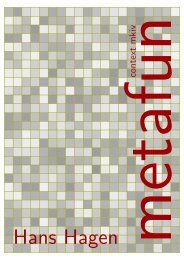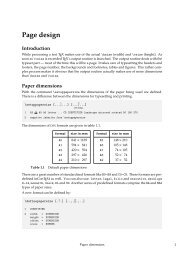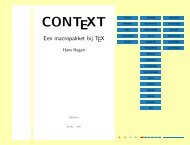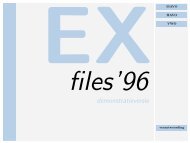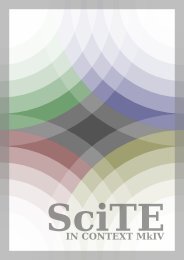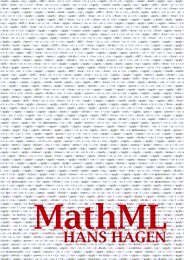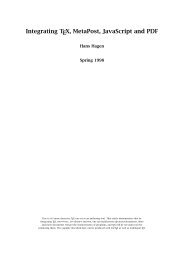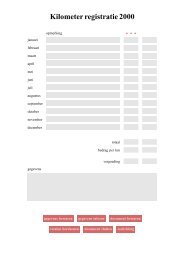MakeMPY manual - Pragma ADE
MakeMPY manual - Pragma ADE
MakeMPY manual - Pragma ADE
You also want an ePaper? Increase the reach of your titles
YUMPU automatically turns print PDFs into web optimized ePapers that Google loves.
makempy<br />
You can use METAPOST to create graphics in a declarative manner. Although there are tools to<br />
create METAPOST graphics interactively, by nature the input is a script defining the graphic.<br />
Plain METAPOST can handle text directly, as strings, or as pictures distilled from TEX output. In<br />
both cases, the text is composed of individual characters, and these somehow will end up in the<br />
POSTSCRIPT file generated by METAPOST.<br />
Although one should not see METAPOST as a full blown system for doing fancy graphic, its usage,<br />
especially in a dynamic document as created by TEX, sometimes demands a more sophisticated<br />
way of handling text. The section titles in this document are an example of this.<br />
In this document I will discuss a way to import text (as typeset by TEX) into a METAPOST graphic.<br />
Although primarily written for usage with CONTEXT, this method is quite generic and also works<br />
well with plain TEX, LATEX or others.<br />
Including text as graphics is far from trivial. First it has to be typeset, and of course we want to use<br />
TEX for that, and in our case PDFTEX suits well. Next we need to convert the typeset text to graphics,<br />
or actually outlines. For that step we will use Wolfgang Glunz’s pstoedit, which can produce<br />
METAPOST code from POSTSCRIPT code. This program falls back on GHOSTSCRIPT for creating the<br />
curves out of the fonts. Because (at least currently) handling PDF directly is not working as<br />
expected, we convert the PDF file to POSTSCRIPT with Derek Noonburg’s pdftops program. This<br />
process is illustrated in figure 1.<br />
During a METAPOST run, the text to be processed is written to a file with the suffix mpo. This file,<br />
which only has TEX directives, is converted to a file with suffix mpy which holds METAPOST code.<br />
1
METAPOST<br />
mpo file<br />
makempy<br />
mpy file<br />
makempy<br />
TEX ConTEXt L ATEX<br />
pdfTEX pdftops pstoedit<br />
Figure 1 The process of conversion.<br />
The conversion is taken care of by a PERL script makempy. This script generates some intermediate<br />
files that are fed into the programs mentioned.<br />
In a next METAPOST run, the mpy file is read in each time a graphic is needed, and the curves are<br />
processed in a special way that permits us to fill and/draw them. We can apply transformations<br />
and use colors and pens. The macros that take care of this are collected in the METAPOST file<br />
mp-grph.mp, which is part of the CONTEXT distribution, but in itself is an independent part of the<br />
MetaFun suite.<br />
We will now demonstrate this mechanism using a typical TEX example.<br />
input mp-grph ;<br />
beginfig(1) ;<br />
graphictext<br />
"$e=mc^2$"<br />
scaled 10<br />
2
dashed evenly<br />
withdrawcolor .7blue<br />
withfillcolor .7white<br />
withpen pencircle scaled 2pt ;<br />
endfig ;<br />
makempy<br />
This example introduces a METAPOST macro graphictext. The first argument of this macro is a<br />
string. After this string you can specify transform operations like a scaling factor, a shift, a rotation<br />
or a combination of these. In addition to the normal color, pen and dash specifications, there<br />
are two special color operators. When fillcolor is provided, the graphic will be also be filled,<br />
otherwise it will be an outline.<br />
In this example, the string to be processed by TEX is given between "". When using METAPOST<br />
this way, you need to be aware of the fact that there can be no line feeds in a string, so a more<br />
complicated formula has to be specified as follows:<br />
graphictext<br />
("$$\pmatrix{D_x&D_y&1\cr} =" &<br />
" \pmatrix{U_x&U_y&1\cr} " &<br />
" \pmatrix{s_x&r_x&0\cr " &<br />
" r_y&s_y&0\cr " &<br />
" t_x&t_y&1\cr}$$")<br />
....<br />
So, we split the string into lines, which we paste with & and surround by (). However, when in<br />
CONTEXT you want to include such more complicated TEX code in a graphic that is defined in the<br />
source, you need to be aware of unwanted expansion. This is why in CONTEXT we can best define<br />
the string separately, which also keeps the graphic more readable. There we have:<br />
\setMPtext{formula}<br />
{$$\pmatrix{D_x&D_y&1\cr} =<br />
\pmatrix{U_x&U_y&1\cr}<br />
\pmatrix{s_x&r_x&0\cr<br />
r_y&s_y&0\cr<br />
t_x&t_y&1\cr}$$}<br />
3
This string can be used as follows:<br />
\startMPcode<br />
graphictext<br />
\MPstring{formula}<br />
scaled 2<br />
withfillcolor white<br />
withdrawcolor .7blue<br />
withpen pencircle scaled .75pt ;<br />
\stopMPcode<br />
makempy<br />
As you can see from the graphic below, you need to adapt the size of the pen to the scale.<br />
In some cases a glyph is composed of multiple outlines. Therefore, by default, the fill is applied<br />
after the draw. As a result, the perceived pen is smaller than the specified one. One can reverse<br />
drawing and filling by supplying the keyword reversefill as demonstrated in the next example.<br />
\startMPcode<br />
graphictext<br />
\MPstring{formula}<br />
scaled 2<br />
reversefill<br />
withcolor .7blue<br />
withpen pencircle scaled .25pt ;<br />
\stopMPcode<br />
As you can see clearly here, big delimiters are composed of pieces.<br />
In addition to the default method and the reversed fill, we also have an outline fill. The differences<br />
show up clearly if we use a dashed line:<br />
4
makempy<br />
\startMPcode<br />
graphictext "MP" scaled 8<br />
withdrawcolor .7blue withfillcolor .7white<br />
dashed evenly withpen pencircle scaled 2pt ;<br />
\stopMPcode<br />
In the reversed fill, we will get a thinner line, since the fill covers half the line.<br />
\startMPcode<br />
graphictext "MP" scaled 8 reversefill<br />
withdrawcolor .7blue withfillcolor .7white<br />
dashed evenly withpen pencircle scaled 1pt ;<br />
\stopMPcode<br />
The outline fill method will extend the fill to the line, which sometimes gives nicer results with<br />
dashed shapes.<br />
\startMPcode<br />
graphictext "MP" scaled 8 outlinefill<br />
withdrawcolor .7blue withfillcolor .7white<br />
dashed evenly withpen pencircle scaled 2pt ;<br />
\stopMPcode<br />
These three definitions result in the following graphics. The third alternative is the least efficient<br />
because the paths are duplicated.<br />
default fill reverse fill outline fill<br />
In the first example of this section, we use plain TEX, while the second and following examples<br />
depend on CONTEXT. You can specify a TEX back-end using the following directive:<br />
graphictextformat := "latex" ;<br />
In CONTEXT you can specify environments in the normal way 1 like:<br />
1<br />
For more information on what is normal, you can consult the MetaFun <strong>manual</strong>.<br />
5
\startMPenvironment<br />
\setupbodyfont[pos,11pt]<br />
\stopMPenvironment<br />
makempy<br />
In a stand-alone METAPOST graphic, you can pass information to TEX using graphictextdirective:<br />
graphictextformat := "latex" ;<br />
graphixtextdirective "\documentclass[]{article}" ;<br />
You don’t have to provide document structuring commands, since these are added by makempy.<br />
You can also use pstoedit independently, in which case each page becomes a figure. You can load<br />
such a figure using the loadfigure macro, as in:<br />
loadfigure("filename.suffix", 4) ;<br />
This macro makes sure that the content of figure 4, when present, is added to currentpicture.<br />
You can also use this macro to include figures defined in other METAPOST files, so that you can<br />
build libraries.<br />
The PERL script makempy uses the following programs:<br />
gs a general purpose POSTSCRIPT processor<br />
pdftops a PDF to POSTSCRIPT converter from the xpdf suite<br />
pstoedit a POSTSCRIPT to whatever vector format converter (often comes with GHOSTVIEW)<br />
When set, the environment variables GS and GS_PROG will be used to identify GHOSTSCRIPT. Of<br />
course you need to have PERL on your system to run makempy as well as PDFTEX (which nowadays<br />
is part of most TEX distributions). If needed, the names of the other programs that are used can be<br />
set with PDFTOPS, ACROREAD and PSTOEDIT.<br />
The makempy script does its work without user intervention. When it deduces that there are no<br />
changes, it will not run at all, otherwise it will report its steps and/or encountered error. The<br />
script takes one argument:<br />
makempy filename<br />
A suffix, when provided, is stripped. The following switches are recognized:<br />
6
makempy<br />
--help returns some basic help information<br />
--silent don’t report status messages<br />
--force always process the file (no checksum test)<br />
--noclean don’t remove temporary files when finished<br />
--acrobat use ACROBAT for conversion (only unix)<br />
--pdftops use PDFTOPS for conversion<br />
--ghostscript use GHOSTSCRIPT for conversion<br />
The last few switches are handy when you encounter errors or get unexpected results. In that case<br />
you can do as follows:<br />
mpost yourfile<br />
makempy yourfile --force --noclean<br />
after that you can take a look at the files whose name start with mpy-yourfile.<br />
mpy-yourfile.tex | .pdf | .log | .pos | .tmp<br />
When using CONTEXT, keep in mind that TEXEXEC uses files with names as mpgraph which can be<br />
prefixed by yourfile, so there we get:<br />
mpy-yourfile-mpgraph.tex | .pdf | .log | .pos | .tmp<br />
At this moment we always use PDFTEX combined with pdftops since it guarantees that we get<br />
everything we need in the file. Experiments with dvips and dvipsone were unsatisfying with<br />
respect to page dimensions and font conversion.<br />
In order to achieve optimal results, a few tricks are used, some of which don’t deserve a beauty<br />
price.<br />
Normally a typeset text will use font sizes between 10 and 30 points, because that’s the way TEX<br />
systems are set up. When such small shapes as font glyphs are converted to curves, we loose quite<br />
some accuracy and the results will be quite awful. For this reason, behind the screens, we scale<br />
the graphic up and down by a factor 10.<br />
Because pdftops has problems with non standard paper sizes, we specify a pretty large working<br />
area when converting the PDF file to POSTSCRIPT. The pstoedit program generates tight code, so<br />
there we will loose unwanted white space.<br />
7
makempy<br />
In order to demonstrate how well TEX and METAPOST can work together, I will give an example that<br />
uses a typeset paragraph. This example uses CONTEXT, but you can of course make an independent<br />
METAPOST figure instead. First we define a graphic:<br />
\startuseMPgraphic{quotation}<br />
graphictext<br />
\MPstring{text}<br />
scaled 2<br />
withdrawcolor .7blue<br />
withfillcolor .7white<br />
withpen pencircle scaled 1pt ;<br />
picture one ; one := currentpicture ; currentpicture := nullpicture ;<br />
graphictext<br />
\MPstring{author}<br />
scaled 4<br />
withdrawcolor .7red<br />
withfillcolor .7white<br />
withpen pencircle scaled 2pt ;<br />
picture two ; two := currentpicture ; currentpicture := nullpicture ;<br />
currentpicture := one ;<br />
addto currentpicture also two<br />
shifted lrcorner one<br />
shifted - 1.125 lrcorner two<br />
shifted (0, - 1.250 * ypart urcorner two) ;<br />
setbounds currentpicture to boundingbox currentpicture enlarged 12pt ;<br />
\stopuseMPgraphic<br />
In this graphic, we have two text fragments, the first one is a text, the second one the name of the<br />
author. We link the quotation and author into this graphic using the following definitions:<br />
\setMPtext{text} {\vbox{\hsize 8.5cm \input zapf }}<br />
\setMPtext{author}{\hbox{\sl Hermann Zapf}}<br />
These definitions assume that the file zapf.tex is present on the system. The graphic, which is<br />
shown on the last page, can now be typeset using the following call:<br />
8
\useMPgraphic{quotation}<br />
makempy<br />
For those not familiar with CONTEXT: the graphic data is written to a file, and processed either<br />
directly or between TEX runs. If you want to know more about the way CONTEXT can interact with<br />
METAPOST, you may want to take a look at the MetaFun <strong>manual</strong> (which also discusses METAPOST in<br />
detail).<br />
Of course you can also process this quotation as stand alone graphic, in which case the METAPOST<br />
code goes between beginfig-endfig.<br />
For CONTEXT users who want to know how the section headers in this document are defined, I let<br />
their definition follow here.<br />
\startuseMPgraphic{text}<br />
graphictext \MPstring{string} scaled 4<br />
withdrawcolor \MPcolor{blue} withfillcolor \MPcolor{gray}<br />
withpen pencircle scaled 2pt ;<br />
\stopuseMPgraphic<br />
\startuseMPgraphic{number}<br />
graphictext \MPstring{string} scaled 10<br />
withdrawcolor \MPcolor{red} withfillcolor \MPcolor{gray}<br />
withpen pencircle scaled 2pt ;<br />
\stopuseMPgraphic<br />
\def\TextCommand#1%<br />
{\setMPtext{string}{#1}%<br />
\framed<br />
[frame=off,offset=overlay,height=3cm,width=\hsize]<br />
{\useMPgraphic{text}}}<br />
\def\NumberCommand#1%<br />
{\expanded{\setMPtext{string}{\currentheadnumber}}%<br />
\hsmash<br />
{\framed<br />
[frame=off,offset=overlay,height=3cm,width=\hsize]<br />
{\useMPgraphic{number}}}}<br />
\setuphead<br />
[section]<br />
[distance=0pt,<br />
9
textcommand=\TextCommand,<br />
numbercommand=\NumberCommand]<br />
makempy<br />
There are two points worth noticing. We define two hooks into the section header command. In the<br />
macro that deals with the section number, we don’t use the number as provided by the argument<br />
#1, but use the raw number instead. We do so, because the content of this argument contains label<br />
related macros, which don’t operate that well when processed independently from this document.<br />
We need to expand the number, because the graphic is processed in an independent run.<br />
The second trick concerns the hsmash. Because the number and text are placed after each other, we<br />
explicitly have to set the distance to zero, as well as makes sure that the number does not consume<br />
space. By using the \framed macro, we get both text and number nicely centered.<br />
We use default font size but pass the colors (red, blue and gray) from this particular document.<br />
The bodyfont environment is passed on to METAPOST’s TEX run by saying:<br />
\startMPenvironment<br />
\setupbodyfont[loc,ppl]<br />
\stopMPenvironment<br />
The PERL script makempy as well as the METAPOST module mp-grph.mp are part of the CONTEXT<br />
distribution. You can find the latest version in the zipped archive that can be fetched from the<br />
download page at:<br />
www.pragma-ade.com<br />
or one of the mirrors. You can also find CONTEXT in the main stream TEX distributions. If you<br />
encounter problems, you may contact:<br />
Hans Hagen<br />
PRAGMA-<strong>ADE</strong>, Hasselt, NL<br />
j.hagen@pragma-ade.com<br />
But for support you can best go to the CONTEXT mailing list:<br />
ntg-context@ntg.nl<br />
This <strong>manual</strong> is typeset at October 28, 2001.<br />
10
makempy<br />
I sincerely hope that Hermann Zapf will forgive me for mis-using his quotation —from an article<br />
on HZ-optimization— as well as for manipulating his Palatino font in this way.<br />
11



